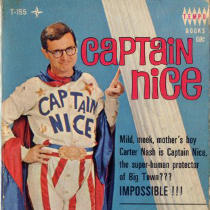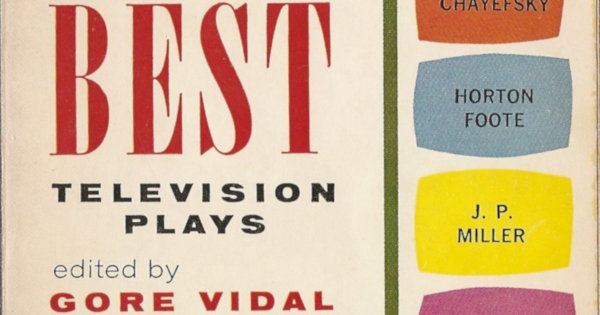I’ve been trying for the past week to figure out the most recent sitcom to receive a tie-in novel. It seems these days only dramas and the occasionally dramedy (like USA’s Monk or Psych on cable) get the tie-in treatment. That’s likely because it is much easier to translate a drama with a fixed format — a murder needs solving or an innocent man defending in the courtroom — than the situations and humor in a sitcom. In the past two decades shows like JAG, Dark Angel, The X-Files, CSI (and its spin-offs), Quantum Leap> and many others have had tie-in novels written. They’re all dramas, though, and many are science-fiction.
But what about the sitcoms? I’d like to, if possible, discount tie-in novels aimed at children. Someone has to remember seeing a book on the shelf, reading it or perhaps even writing it. What’s the most recent sitcom to have a tie-in novel? Hit the comments.








You can find out more about TV tie-ins at http://www.iamtw.org…the home of the International Association of Media Tie-In Writers.
I will pose your question on the private member newsgroup…maybe one of the member is writing a sitcom tie-in.
Lee
that should have been:
http://www.iamtw.org
Lee
Though it is admittedly aimed at teens, my iCarly novel iGo to Japan, based on the TV movie, will be released on January 1, 2010.
There are two answers. The first is the US answer:
Sitcom tie-ins aimed at adults are ALMOST non-existent. One can argue about the seemingly endless batch of William Johnston sitcom tie-ins, as he was the go-to guy for sitcom originals, from the 60s through the 80s, especially anything that would bear the weight of a book series, but even those were skewed toward the youth market — even the GET SMARTs we loved, published by Tempo, the YA imprint of Grosset and Dunlop. (I think the *one* that irrefutably adult was Burton Wohl’s adaptation of six or seven ALL IN THE FAMILY episodes, and of the *few* that could have skewed either way, Jerry Fay did a brilliant job adapting early episodes for two BEVERLY HILLBILLIES books, and Jack Sharkey displayed a gleefully wicked sense of humor in the first of the two ADDAMS FAMILY books [he didn’t write the second]. What makes Sharkey’s original book interesting and, I think, unique, is that it’s only loosely a novel … he essentially adopted the sitcom structure and wrote his own “episodes” one per chapter. As far as I know, the only author to do anything similar, with somewhat longer form stories, was Keith Laumer, in his two books based on THE INVADERS.)
William Johnston had a delightful sense of whimsy, and a rare knack for nailing down comedy, because he understood how timing works on the page and knew just to stay the hell out of the way of the rhythm. Most other writers who attempted comedy tie-ins really couldn’t do it, and wound up writing these weird little intrigues, as if the sitcom characters had suddenly been wrenched out of their universe of canned laughter and thrown into a drama. Paul Fairman’s THAT GIRL was pretty much a gothic romance; and Burt Hirschfeld (my god, remember *his* potboilers?) threw THE UGLIEST GIRL IN TOWN into some kind of spy adventure, with guns and real bullets and bodies and everything. (Authors who weren’t Johnston had better luck with light comedy movies, but even then, very few had the knack — though among them were Marvin H. Albert, Robert W. Krepps, E.W. Hildick, Linda [as “Sam”] Stewart, Robert Grossbach and a number of folks who novelized their own screenplays.)
Probably the closest you could come to a sitcom tie-in — a book which is, amazingly, still in print — is Ellis Weiner’s LETTERS FROM CICELY (1992), a trade paperback edition disingenuously marketed as “A NORTHERN EXPOSURE Book” but which is in fact an epistolary novel, and an extremely clever and well-done one. If you haven’t read it, I’d count it as a tie-in classic.
The second answer id the U.K. answer:
Here tie-ins based on sitcoms, written for the adult market abound, many in the ’80s and into the ’90s. Many (though not all) published by the BBC. Frequently (perhaps most times) they were written by the scribes who created the series and wrote the scripts. Arguably the most ubiquitous of these is David Nobbs, who had a knack for creating series that were PART non tie-in novel and PART tie-in (e.g. the REGINALD PERRIN trilogy; the character was introduced in a novel. Nobbs adapted its episodic structure for the show’s first season … then wrote two novels based on the scrips he wrote for the next two seasons, and some years later, the sequel, set after Perrin’s death [in the wake of star Leonard Rossiter’s death] called THE LEGACY OF REGINALD PERRIN. There were several other series for which he performed similarly.)
There were also brilliantly elaborate tie-ins by creators Jonathan Lynn and Anthony Jay of their creation YES MINISTER (3 volumes) and its sequel YES PRIME MINISTER (2 volumes) — each book series later collected into its own hardback omnibus volume — in which the episodes were adapted in the form of private papers from the three major players and various government files and public documentation. They’re profusely illustrated, handsome books and are among the smartest, best tie-ins ever.
And there were a number of straight-ahead script adaptations by the original dramatists, such as the two book TO THE MANOR BORN series by Peter Spence.
Occasionally these tie-ins were written by scribes other than the scripters: the late Paul Ableman, who was himself a wonderful dramatist, wrote the books based on HI-DE-HI and a MINDER title (MINDER was a sitcom in the way that MONK is a sitcom: mostly humorous but not always played for laughs, though light comedy dominated) called STRAIGHT UP! THE AUTOBIOGRAPHY OF ARTHUR DALEY, which managed to be both original and adaptation at the same time. Anthony Masters did three books of MINDER script adaptations (four eps per book) and there were several MINDER specialty books of humorous philosophical musings (also written as if by Arthur Daley) too. (One of which was even by series creator Leon Griffiths — who had also authored a PREQUEL novel to the series, published before it began airing.) To return to scribes who were contracted to write books based on scripts by others: Gerald Cole adapted THE BOUNDER, Christine Sparks did OPEN ALL HOURS and I’m sure there are others I’ve forgotten.
Though for the most part this breed of tie in too has dwindled (in the wake of box sets and electronic preservation of the shows, I guess) there are two book series that are far more recent —
— and of course, they are RED DWARF, by its creators, Doug Naylor and Rob Grant; and THE HITCH-HIKER’S GUIDE TO THE GALAXY by Douglas Adams, which originally began as a BBC Radio serial. Naylor and Grant together (as “Grant Naylor”) penned two RED DWARF books of liberal episode adaptations: INFINITY WELCOMES CAREFUL DRIVERS and BETTER THAN LIFE, which had their own internal and linking continuity. The authors were contracted to Penguin for two more books, but Grant decided to go off on his own and pursue other things besides RED DWARF, which led to one of the more unique follow ups in tie-in history: they each wrote their own sequel to the book series, starting from book #2’s endpoint, and each book follows a greatly contrasting path. (LAST HUMAN by Naylor, added Kochanski to the crew and placed more emphasis on the science-fiction and plot elements, while BACKWARDS, by Grant, is more in keeping with the previous two novels, borrowing more extensively from established television stories.)
As for HITCH-HIKER’S … most of us know the history. Plus … the first post-Adams entry in the series, AND ANOTHER THING by Eoin Colfer, is going to be released any minute.
So I guess the answer to “when was the most recent sitcom tie in” is … astonishingly … comin’ up.